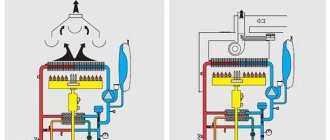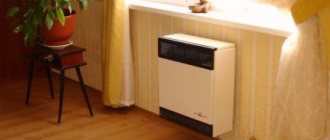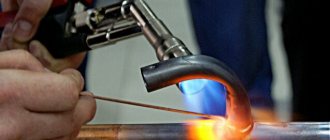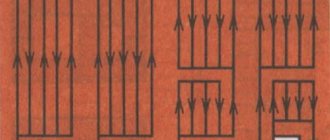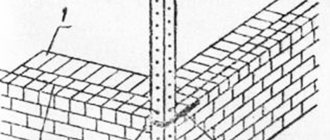Author: Yuriy Fedorovich Kolesnikov, thermal power engineer
The purpose of this article is to tell you how to make a gas burner with your own hands. Gas burners in small businesses, individual technical creativity and in everyday life are used very widely for soldering, metalsmithing, forging, roofing, jewelry work, for starting gas heating devices and producing flames with temperatures above 1500 degrees for various needs.
In the technological aspect, a gas flame is good because it has a high reducing ability (cleanses the metal surface of contaminants and restores its oxide into pure metal), without exhibiting any noticeably different chemical activity.
In heat engineering – gas is a highly energy-intensive, relatively inexpensive and clean fuel; 1 GJ of gas heat is, as a rule, cheaper than from any other energy carrier, and coking of gas heating devices and soot deposition in them is minimal or absent.
But at the same time, let us repeat the common truth: they don’t joke with gas. A gas burner is not so complicated, but how to achieve its efficiency and safety - this will be discussed further. With examples of correct technical execution and recommendations for making it yourself.
Using gas burners at home
Review of gas burners
When choosing a device, you should take into account its technical characteristics, type of fuel supply, compatibility with other devices and principle of operation.
Several types of burners are popular among consumers. Let's start the review with the modification of the KChM. Most often it is used in boilers converted from solid fuel analogues or LNG. The design is equipped with three nozzles and automation. The second popular type of gas burners is “Hearth”. The device is a pneumatic mechanism with automatic functionality. It has an increased level of security and stops working in the following cases:
- With a lack of traction.
- If the flame goes out.
- Due to a disruption in the natural gas supply.
“Hearth” has a fuel pressure controller, which makes it possible to optimize combustion, even if there are failures in the main system. These models are easy to maintain; soot does not accumulate in the convective compartment.
What is
A gas burner for a cauldron is a special equipment used for convenient and quick cooking during camping trips. The device has a simple design, which allows you to make it yourself. The body consists of a glass, a handle, a holder, a gas hose, among other elements - two gearboxes, one of which is used to supply fuel, a nozzle, a head, and a unit for attaching a gas cylinder. The burner power can be from 2 to 7 kW. There are installations with and without legs. The units are manufactured from durable metal, which ensures long service life.
The gas burner is easy to maintain, but requires periodic testing of its functionality. Since the equipment does not create soot, the dishes are easy to clean after cooking. Most burners are equipped with piezo ignition, which allows you to quickly ignite a fire without the use of matches or a lighter.
Burners with forced air supply and preliminary preparation of the gas-air mixture
Combination burner GBL-1,2 COMBI
Burners with forced air supply and preliminary preparation of the mixture are most widespread. The gas flow through these burners can be very small (fractions of a cubic meter per hour) and very large (5000 m3/h or more). In burners of this type, it is possible to ensure a predetermined quality of preparation of the mixture before it enters the embrasure or firebox. To speed up the mixing process, gas is most often supplied through a series of slits or holes, the axes of which are directed at an angle to the air flow. When gas jets are supplied into the air flow from the center to the periphery, the burners are called “with central gas supply”, when supplied from the periphery to.
In many burners, air is supplied to the point of mixing with gas in a swirling flow. The most common devices for twisting are: guide vanes with a constant or adjustable blade angle, snail-shaped burner body, tangential air supply to the cylindrical body. In burners for high-capacity boilers, tangential blade swirlers are also used. An increase in the degree of twist intensifies the processes of mixture formation and fuel combustion, but at the same time the burner resistance and energy consumption increase.
Depending on the design of the burner, the quality of mixing gas with air can be very different: in the mixing chamber, the preparation of the gas-air mixture can only begin, ending with the combustion process, or it can be completely prepared for combustion. The mixing chamber of the burner usually has a small volume, and the speed of the mixture leaving the mouth at a rated thermal power is 10-50 m/s.
Combined burners - oil-gas and dust-gas, as a rule, have a forced air supply. The fuel oil nozzle is located along the axis of the burner and, depending on the design adopted, during gas operation it is removed or moved away from the mouth to avoid overheating. To burn fuel oil, air is used, supplied through the same air guide devices that are used when operating on gas fuel.
Based on materials from the book “Combustion of gases in the furnaces of boilers and furnaces and maintenance of gas facilities of enterprises” Chepel V. M., Shur I. A. 1980
Rules for safe operation of equipment
If used incorrectly, gas cylinder equipment can become a source of a strong explosion or fire.
When performing welding work, you should definitely use personal protective equipment: glasses, gloves, special shoes.
Before starting work, you need to thoroughly inspect the equipment for damage. If the equipment gets dirty, be sure to remove the dirt
You can work with propane cylinders only in well-ventilated areas, and the air temperature should not be below 0 °C.
Absolutely forbidden:
- Work near open flames.
- Keep the cylinder tilted when working.
- Place the vessels in the sun.
- Carry out work without a gearbox.
- Heat the gearbox over an open fire.
In addition, if you smell gas, you must immediately stop working and turn off the valve on the cylinder. We also recommend that you familiarize yourself with the main reasons for the explosion of gas cylinders.
When working without personal protective equipment, you can get burned, not only from an open flame, but also from accidentally touching hot parts.
If the considered homemade burners are not suitable for you, we recommend that you familiarize yourself with other options for making useful homemade products discussed in our articles - a burner made from a blowtorch and a burner for a sauna stove.
Popular varieties
Now let's look at the most common models.
With soldering attachment
This device is intended for heating medium-sized parts, as well as for compact soldering. This occurs due to heating from the sting flame. Such a torch can easily be called a soldering iron without wires. The gas reservoir has a capacity of 8 milliliters. When filling with butane, the flame temperature is 1300 degrees, and the tip temperature is 450. The flame length can be adjusted within 4-6 centimeters. The diameter of the burner is 1.5 centimeters and the length is 13 centimeters.
The price of this model is approximately 400 rubles.
Advantages:
- easy refueling;
- presence of a nozzle for contact soldering;
- the refill is enough to seal several medium-sized parts;
- low price;
- compactness.
Disadvantages: there is no piezo ignition.
Micro burner
There is nothing in this device except a nozzle with a gas supply regulator and a tank with a filling valve. It does not have piezo ignition and is supplied unfilled. In this regard, you will have to additionally purchase a gas can (can be used for lighters). Such a burner is enough to heat heat shrink or solder two wires without a soldering iron. The weight of such a device is 43 grams, and the length is up to 20 centimeters.
The price of the equipment is 200 rubles. This is the cheapest device of this type.
The advantages are the following parameters:
- easy refueling;
- the lowest price.
Flaws:
- there is no piezo ignition;
- the gas station runs out quickly;
- the flame is small.
Mini soldering iron KVT XZ-1
This is a remarkable device from a brand that produces gas equipment. It has piezo ignition. The set includes: 4 soldering tips, a tip cleaning sponge, and a solder spool.
For contact soldering, the stated power of the soldering iron is 137 W. For a soldering iron weighing 120 grams and 21 centimeters long, this is a lot. Electric soldering irons have never even dreamed of such weight and size characteristics. This soldering iron is not positioned as a torch, but it can be used in this capacity - the flame comes out like a pencil.
The price of such equipment is 2300 rubles.
Disadvantages: high price.
Advantages:
- high thermal power;
- good case;
- there is a set of components;
- convenient for soldering;
- famous brand.
Iris Barcelona
This type of equipment is intended for repairing jewelry and electronic equipment, welding and soldering. Its flame is adjustable. You can refill with a regular gas cylinder, which is intended for lighters. The flame can reach a length of up to 3 centimeters, and the temperature can reach 1300 degrees. It can work for approximately 20 minutes. The length of the device is 20 centimeters.
Such a device costs 1,500 rubles.
Advantages:
- brand;
- presence of piezo ignition;
- small dimensions.
Disadvantages: the flame does not allow processing large and medium-sized parts.
Butane torch KVT X-220
Intended for repair and construction work. Looks stylish. The handle is corrugated and pleasant. The flame ignition system is piezoelectric. The capacity of the cylinder for highly purified butane is 22 millimeters. This volume of gas is enough for 110 minutes of continuous operation. The flame reaches a length of 3-8 centimeters, and its shape is adjustable from wedge-shaped sharp to soft with yellow tongues. The device is 14 centimeters long and weighs 226 grams.
Such a device costs approximately 1,600 rubles.
But the advantages are:
- comfortable handle;
- presence of piezo ignition;
- presence of a stand;
- is a good option for desktop work.
Flaws:
- You can’t get into a narrow place;
- large dimensions. Because of this, it will not fit in your pocket.
Manufacturing parameters
Before assembling the burner, you should determine in advance the required parameters, the main ones of which are:
- Flame type – torch or vortex. The design of flameless burners is too complex to make at home. The torch flame affects a small area and is used for precision welding. Using a vortex, you can quickly heat large surface areas.
- Flame adjustment device. The regulator allows you to reduce sludge and increase flow depending on the material and processing method. A water valve can be used for control.
Homemade units
There are craftsmen who remake heating systems with their own hands. On the Internet you can even find the necessary diagrams for changing the devices of gas burners, their installation and adjustment.
Typically, metal is used as a material for the manufacture of heating systems. A cast iron firebox would be much more reliable. However, it is not possible to use it at home.
An excellent option for manual work is to order the system from specialists. They will be able to manufacture the device in accordance with all the customer’s wishes. However, the possibility of defects in the boilers cannot be ruled out, which may appear after some time.
Why do you need homemade heating units? The fact is that the marked options have a lower cost. They are made mainly because of the desire to save money. At the same time, these options are inferior to their factory counterparts in efficiency.
Usually only solid fuel and electric units are manufactured. Making a gas or diesel boiler is extremely dangerous. In addition, their installation in the house is strictly prohibited.
According to the principle of operation, a homemade product is no different from a purchased version. It will burn fuel and heat the coolant filled with water.
The main disadvantage of this unit is the lack of warranty. Factory equipment will work and perform its functions. Even if the buyer stumbles upon a defect, he will be able to exchange the product for another.
It is better to use pellets, firewood, and coal as fuel in self-made units. These materials are less dangerous than gas. It is impossible to make heating devices based on the latter.
Simple solid fuel units are the most popular and widespread homemade devices. They are simple, and their design is in many ways similar to a conventional stove. In addition, they are versatile.
Like a conventional stove, these systems can operate on any solid fuel. The main thing is that it burns.
Main parts of a gas boiler.
The efficiency of homemade equipment is significantly lower than factory equipment. It is influenced by many factors.
Among them:
- thermal insulation;
- combustion completeness;
- the correctness of the conclusions.
The efficiency of the unit directly depends on the combustion temperature. The higher it is, the lower the efficiency. In high-quality systems, the temperature in the firebox is maintained at 120–150°C. Higher values reduce the safety of pipes. This in turn significantly reduces the durability of the unit.
When manufacturing heating boilers with a burner, it is better to protect yourself as much as possible from the possible consequences of its operation. Therefore, you should consider a separate purchase of an automatic gas burner, which will be installed in an atmospheric or blown boiler.
You can also make electric heating units with your own hands. Their design may vary. It all depends on the person’s needs. The simplest option is to install a heating element directly into the heating system. In this case, there is no need to make a boiler.
The pipe with the heater must have a sufficiently large diameter. It should be easily removable for repairs and cleaning.
Systems without a heater deserve special attention. Its role is played by water itself. A current is passed through it, and heating occurs due to the movement of water ions. The liquid itself must contain salt.
It is extremely difficult to make such a device. Electric current passes directly through the coolant, so the entire system must be reliably insulated.
One of the dangers of this device is electrical breakdown. Essentially the same as a short circuit. Gas may also accumulate in the system. As a result, heating efficiency will decrease.
From all of the above, the best option is a solid fuel unit. Its body can be assembled from heat-resistant steel. It is characterized by increased strength, less wear and high resistance to thermal influences.
However, heat-resistant steel is expensive and in practice is rarely used in homemade boilers. Another option is cast iron: this material tolerates heat well, although it is difficult to work with. Equipment for the manufacture of cast iron stoves is available only at specialized enterprises.
It is important to understand that without the proper experience and skills, it is better not to make a heating system yourself. Safety must come first
It is enough to make even one inaccuracy, and this can lead to disastrous consequences.
Air-gas injection burners
Burners of this type are called injection, since air is sucked into them (injected) due to the energy of gas jets emerging from one or more nozzles. With a single-nozzle burner, a stream of gas coming from a gas pipeline under pressure is ejected from the nozzle at high speed, as a result of which a vacuum is created in the mixer injector. Due to rarefaction, the surrounding air is sucked into the burner and, when moving along the mixer, mixes with the gas. The gas-air mixture passes through the throat of the mixer (narrow part), which levels out the flow of the mixture, and enters its expanding part - the diffuser, where the speed of the mixture decreases and the pressure increases. After the diffuser, the gas-air mixture enters either the confuser, where its speed increases to the calculated speed, and is supplied through the mouth to the combustion site, or into a manifold with fire holes. Coming out of these holes, the gas-air mixture burns in the form of small bluish-violet torches with an inner cone of greenish-blue color.
Injection burners are divided into medium-pressure burners, capable of injecting all the air necessary for complete combustion of the gas, and low-pressure burners, most often injecting only part of the air, which is called primary. The rest of the air - secondary - enters the combustion zone due to rarefaction in the firebox or due to convection in the atmosphere. Stable operation of medium-pressure burners without flame loss is possible only with the presence of a flame stabilizer. Low pressure burners can operate without special stabilizing devices.
A characteristic feature of the operation of injection burners is the dependence of the primary air consumption coefficient α primary on the vacuum (back pressure) in the furnace. At a constant position of the air damper, α first increases with increasing vacuum, and decreases with increasing back pressure. The greater the pressure of the injection gas, the less this dependence affects: the vacuum (back pressure) in the furnace has the greatest effect on the operation of low-pressure burners, the minimum - on the operation of medium-pressure burners at a pressure in front of the nozzle of more than 0.4-0.5 kgf/cm2.
Some designs of injection burners do not have a diffuser part (injection and mixing occur in a cylindrical mixer) and a control air damper.
Main advantages: no energy consumption for driving a fan to supply air, automatic maintenance of the calculated ratio of the quantities of gas and injected air within certain limits and their good mixing. Disadvantages: limited control range with an α value of about 1, high noise level when using medium and high pressure gas, dependence of injection capacity on the degree of vacuum in the furnace, difficulty in using heated air.
How to start a car in severe frost and not burn the car
When the thermometer mark exceeds minus 30, starting a car in cold weather becomes very difficult. And each such launch reduces the life of the car several times faster, unlike a summer launch.
VashGorod.ru has made a selection for motorists who decide to start their iron horse in 40-degree frost.
When warming up a car, many people use various “folk” methods: pouring hot water over the engine, warming up the car at a car wash, heating the engine with a gas burner flame, construction or household hair dryers and other heating devices. Let's look at each method in more detail.
Battery resuscitation
When the air temperature is very low in winter, the battery in the car freezes first. If you come to the parking lot in the morning and find that the car does not want to work, try removing it and taking it to a warming room. Or you can ask someone to “light” you, but for this you must have special wires, popularly called “crocodiles”.
Hot water for the engine
If the reason is not the battery, then craftsmen advise pouring boiling water from a kettle over the intake manifold, this will certainly increase the temperature of the air-fuel mixture, but there is a risk of flooding the wiring connectors with water, so you need to act very carefully, you can even cover the manifold with a rag and little by little pour water on her.
With a twinkle
It is not recommended for beginners to warm up a car using a gas burner due to the great danger of this method. But if you decide on this method, then you will need a metal pipe with a diameter of 30 mm and a length of about 1.5 meters. One edge of the pipe (100 mm) must be bent at a right angle. Place the bent edge on the engine and apply a blowtorch to the other end of the pipe.
However, you should carefully warm up the car using this method and before the procedure, check whether there are any oil or gasoline leaks on the surface of the pan
Hairdryers, stoves, guns
Anything that heats up can also be useful. Some people warm up the engine using a heat gun (from the crankcase side) or a heat gun. With this method, the torque converter of the automatic transmission also warms up (automatic transmissions are more sensitive to frost). An electric hotplate, which is placed under the crankcase, can also be useful.
The “disadvantage” of these methods is that to operate both the hairdryer and the stove, you will need a 220 V electrical outlet. Although you can purchase a heat gun that runs on gasoline.
Candles are flooded
Flooded spark plugs are the most common reason why a car won't start. You don't need much effort to fill the spark plugs - just try to start the engine a couple of times to no avail. As a result, gasoline continues to flow into the combustion chamber, flooding the spark plugs.
What to do if the candles are flooded?
There are two ways: for the lazy and for those who are impatient.
If your car does not start, and you do not want to unscrew all the spark plugs, turn off the ignition and just wait a little, sit in the car, pressing the gas pedal. Through an open throttle valve, a pair of cylinders will be ventilated, and there is some chance that the gasoline in them will evaporate and the spark plugs will dry out. After 2-3 minutes, try to start the engine.
When using the second method, you need to unscrew all the spark plugs and take them to a warm room. After thoroughly drying the spark plugs, it is advisable to heat them (or “calcinate” them, as experienced car owners say). The easiest way to do this is to place them on the stove. When the candles heat up to the point that they cannot be held with your hands, transfer them from the stove to a previously prepared cloth and quickly bring them to the car. The hotter the candles are at the moment of twisting, the greater the chance that everything will end successfully.
Warm box
If you have tried everything possible and have not achieved a positive result, then you should call a tow truck and send your vehicle to a heated parking lot.
But the best way to avoid freezing is to keep your car in the garage or constantly warmed up.
Attention! When heating, you should not neglect the advice from the Ministry of Emergency Situations, so as not to be left without a car. Do not charge batteries directly on vehicles
Do not charge batteries directly on vehicles.
Do not warm up a frozen engine with open fire (torches, blowtorches) and do not use open fire sources for lighting.
Types of burners
According to their design and functional differences, burner devices are divided into:
By purpose:
- for high power industrial equipment
- for household equipment.
By type of fuel used:
- devices for natural gas;
- devices for liquefied gas;
- universal devices.
By adjusting the flame:
- single-stage – capable of operating on/off;
- two-stage (as a variation - models with smooth modulation) - operate at full power, when the desired temperature is reached, the flame is reduced by half;
- modulating - boilers with a modulating burner are characterized by smooth adjustment of the flame power.
According to the principle of operation:
- injection/atmospheric. They operate by supplying air from the room. They are installed respectively in open combustion chambers. Also used for old-style boiler models.
- fan/supercharged. They work in isolated combustion chambers. Combustion air is supplied by a fan. According to their design features, they are divided into: - vortex (round-shaped nozzle holes) - direct-flow (shape of a narrow slot with a round/rectangular cross-section).
- diffuse-kenetic. Air enters two simultaneously: one is mixed with gas fuel, the second is added directly to the chamber during combustion.
Which one should I do?
Low-power gas burners for everyday life and small private production are classified according to performance indicators as follows. way:
- High-temperature – for precision soldering and welding, jewelry and glassblowing. Efficiency is not important, you need to achieve the maximum flame temperature for a given fuel.
- Technological – for metalworking and forging work. The flame temperature is highly desirable not lower than 1200 degrees, and subject to this condition the burner is brought to maximum efficiency.
- Heating and roofing systems achieve the best efficiency. The flame temperature is usually up to 1100 degrees or lower.
Regarding the method of burning fuel, a gas burner can be made according to one of the following. schemes:
- Free-atmospheric.
- Atmospheric ejection.
- Supercharged.
Atmospheric
In free-atmospheric burners, gas burns in free space; air flow is ensured by free convection. Such burners are uneconomical; the flame is red, smoky, dancing and beating. They are of interest, firstly, because with an excess supply of gas or insufficient air, any other burner can be switched to free-atmospheric mode. It is here that the burners are ignited - at a minimum fuel supply and even less air flow. Secondly, the free flow of secondary air can be very useful in the so-called. one-and-a-half-circuit burners for heating, because greatly simplifies their design without sacrificing safety, see below.
Ejection
In ejection burners, at least 40% of the air required for fuel combustion is sucked in by the gas flow from the injector. Ejection burners are structurally simple and make it possible to obtain a flame with a temperature of up to 1500 degrees with an efficiency of over 95%, therefore they are used most widely, but cannot be made modulated, see below. According to the use of air, ejection burners are divided into:
- Single-circuit - all the necessary air is sucked in at once. With a properly profiled gas channel at a power of more than 10 kW they show an efficiency of over 99%. Can't be repeated with your own hands.
- Double circuit - approx. 50% of the air is sucked in by the injector, the rest into the combustion chamber and/or afterburner. They allow you to get either a flame of 1300-1500 degrees, or a CPL of over 95% and a flame of up to 1200 degrees. Used in any of the ways listed above. Structurally they are quite complex, but repeatable on their own.
- One-and-a-half-circuit, often also called double-circuit - the primary air is sucked in by the flow from the injector, and the secondary air freely enters a limited volume (for example, the furnace firebox), in which the fuel burns out. Only single-mode (see below), but structurally simple, therefore they are widely used for temporarily starting heating stoves and gas boilers.
Supercharged
In pressurized burners, all air, both primary and secondary, is forced into the fuel combustion zone. The simplest supercharged microburner for benchtop soldering, jewelry and glass work can be made independently (see below), but the manufacture of a supercharged heating burner requires a solid production base. But it is the supercharged burners that allow you to realize all the possibilities of controlling the combustion mode; according to the terms of use they are divided into:
- Single-mode;
- Dual mode;
- Modulated.
Combustion control
In single-mode burners, the fuel combustion mode is either determined once and for all by design (for example, in industrial burners for annealing furnaces), or is set manually, for which the burner must either be extinguished or the technological cycle with its use must be interrupted. Dual-mode burners usually operate at full or half power. The transition from mode to mode is carried out during work or use. Heating (winter - spring/autumn) or roofing burners are made with two modes.
In modulating burners, the supply of fuel and air is smoothly and continuously regulated by automation, working according to a set of critical initial parameters. For example, for a heating burner - according to the ratio of temperatures in the room, outside and coolant in the return. There can be one output parameter (minimum gas flow, highest flame temperature) or there can also be several of them, for example, when the flame temperature is at the upper limit, fuel consumption is minimized, and when it drops, the temperature for a given technical process is optimized.
Principle of operation
Portable mini-gas burners with piezo ignition can be of different designs. For some models, the cylinders may be disposable, while for others they can be removable, and still others even work with stationary ones. Many portable burners have piezo ignition to make starting a fire safe and easy. This device is mainly used for soldering copper pipes or other products made of not very refractory metal. During soldering, different solders are used - liquid or solid soldering acids.
During operation, the mixture contained therein is supplied from the cylinder: acetylene, propane or butane. The gas enters the nozzle and is ignited there. The flow of fire that has formed allows the part to be heated to the required temperature at which soldering will be possible.
A portable mini-torch with piezo ignition can be used for soldering wires, cables, pipes, copper, as well as for repairing electronics with various types of solders. It may also be useful for repairing some parts in the car (radiator and others).
But the scope of application of a device with piezo ignition is not limited to soldering of products. It can also be used in some plumbing work, during corrosion of products or during dismantling to warm up parts.
There are also some non-standard ways to use a portable device. If you like fishing, picnics or hunting, then this device may be useful to you in the field. It can be used to quickly heat up food or start a fire. Using this unit, you can quickly scorch game while hunting.
Application
The scope of use of this equipment is very wide. It can be useful for installing climate control systems, repairing cooling equipment, carrying out plumbing work and other operations. It is often necessary to use this device even when making jewelry. In these cases, one or another type of equipment may be required.
Gas burners are classified according to the following principles.
- According to the method of adjusting the flame - with a power regulator or piezo ignition.
- The nozzles are replaceable, rotating, and resemble a spear.
- According to the scope of application - equipment of a narrow focus and multifunctional.
Criterias of choice
The correct choice of device is carried out with full knowledge of the technical properties of the metal and the gas used, the first being of paramount importance, especially the refractoriness of the materials being welded.
To solder copper or cable, you will need a specialized torch, which can be purchased at a retail chain in large cities, for example, in Moscow.
Technical features:
- The flame power varies depending on the type of work: desoldering electronic parts is the minimum value, and for heating metal for forging is the maximum value.
- The shape of the torch is also related to the types of operations: heat shrinking or heat treatment of large surfaces requires a wide torch, and for soldering a high-precision needle-shaped contour flame is used.
- The plastic case is budget-friendly and is used for work with low operating temperatures and short processing periods, otherwise the plastic may melt.
- Flame stability is determined by the ability to work at an angle of up to 45.
- The presence of replaceable attachments is a welcome feature for users to be able to perform different tasks.
- Special requirements: design shape, stability, presence of protective functions, for example, wind protection.
- Connection options for cans, threaded connections, the most reliable and common with maximum tightness.
- Containers are selected based on the volume of welding work: from 5 to 50 liters.
- The hose must be long enough to reach the work site.
- A propane reducer is used with a pressure gauge to monitor the presence of gas.
Gas burners for roofing work
Design features of the gas burner
This element of the unit creates a stable flame; it is in the burner that the fuel entering the device is burned. Then the resulting heat moves upward, where there is a heat exchanger through which the coolant liquid moves. Combustion products and excess heat escape into the atmosphere in one way or another.
The gas burner has a simple design; it consists of several main components, including:
- Nozzle – used to release gas.
- Ignition system – designed to ignite gaseous fuel.
- A sensor that monitors the presence of a burning flame.
- Automation system – monitors temperature indicators.
This is how the design looks simplified.
Modern gas burners for heating boilers are devices that must meet a number of requirements:
Quiet operation. Is an important quality. Many consumers are familiar with Soviet-era instantaneous water heaters, in which the flame made a lot of noise. But modern models operate relatively quietly. Also, when choosing a device, you should pay attention to the ignition, since there should be no explosions or pops. The noise level is additionally affected by the design of the combustion chamber.
Long period of operation In older models of gas units, burners worked for a long time, since at that time the equipment was made to last. Nowadays such technologies are not used, so these elements installed in gas boilers break down quite often. In this case, experts recommend purchasing devices manufactured under well-known brands, for which they use high-quality components. You should not buy Chinese equipment of unknown manufacture and cheap domestically produced boilers, since they often have short-lived burners installed.
Complete combustion of gaseous fuel
This is an important requirement, since the burner must burn natural gas completely with minimal release of combustion products and other associated compounds, including carbon monoxide. The degree of combustion is also affected by other components
We should not forget about arranging high-quality gas removal - for this you need to make a chimney that has good draft.
The operating principle of a gas burner is simple:
- The unit detects the presence of a discrepancy between the temperature in the heating circuit and the indicators specified by the equipment users.
- After opening the gas valve, fuel enters the burner.
- At the same time, the ignition system is activated.
- Once the gas is ignited, a flame appears.
At the same time, the flame sensor starts working, which monitors its presence: if the fire suddenly goes out, the automation shuts off the fuel supply. Once the heating system reaches the required temperature, the gas supply stops.
Which is more convenient: long or short?
If you value ease of use, then purchase a lever roofing burner, in which you do not need to constantly tighten and unscrew the valve. But how long should the handle be?
Thus, the length of the burner is not a style, but an important functional point: short ones, which do not exceed half a meter in length, usually make partial repairs, heat up individual areas and melt the necessary areas of the roof. But for larger-scale work, you will need a burner with a length of at least 80 cm.
Types of burner ignition
A modern instantaneous gas water heater is produced with automatic ignition and a manual pilot ignition system.
For economic reasons, manual ignition is unprofitable. The system consists of a piezoelectric element activated by pressing a button. Pressing a key produces a spark that ignites the igniter. The operation is simple, but the igniter constantly burns throughout the day, consuming gas. It is irrational to turn it off, since you will often have to re-ignite it when you need to consume hot water.
Auto-ignition occurs immediately after opening the hot water tap:
- The first operating principle of electronic ignition is based on batteries. The waiting igniter does not light. When the mixer tap is opened, the pressure in the water supply changes and the sensor gives a signal to the electronic unit to ignite. The energy from the batteries creates a spark. The flame lit on the igniter ignites the burner. Having done its job, the igniter turns off until the next start. Battery ignition does not require much energy. The battery charge lasts for a year.
- The second operating principle of auto-ignition is based on a hydrogen generator. The instantaneous gas water heater is equipped with a turbine instead of batteries. It is driven by the flow of water created in the water supply when the mixer tap is opened. The hydrogenerator produces a spark that ignites the igniter.
Gas water heaters with automatic ignition are beneficial due to lower gas consumption and ease of use.
In what cases is it necessary to adjust the burner flame?
An atmospheric gas burner for heating equipment often fails. It is equipped with models of both wall-mounted and floor-standing boilers. The injection burner of floor-standing equipment reduces its efficiency for various reasons:
- Burner power is too high. This happens when a high-power burner is purchased for small heating equipment. At the same time, there is not enough space for combustion, the air flow for such power is weak, which leads to the transition of the flame from blue to yellow, sooting of the combustion chamber and chimney.
- If the chimney is poorly cleaned, the boiler draft deteriorates. At the same time, waste combustion products are poorly removed, and the air flow is small. This worsens combustion and the flame turns yellow.
- A defect in the burner itself does not make it possible to correctly adjust the complete combustion of the fuel.
- Due to pressure changes in the gas supply system, well-regulated equipment can release large amounts of unexhausted gas into the chimney. Partially it settles with soot and soot. A large layer of soot reduces traction and increases fuel consumption.
- Starting heating equipment after repair.
- The presence of extraneous noise during operation of the boiler or gas burner.
- Changing the type of fuel.
Gas oven thermostat
In order for the oven to work correctly and food to cook within the specified temperature range, a thermostat or thermostat is installed inside the cabinet. They can be mechanical, electromechanical, or electronic; to control a given mode, a rotary knob, button, or other, more complex and highly accurate devices are used. What is a thermostat in a household gas stove and how does it regulate the operating mode of the oven?
Gas stove thermostat diagram:
Diagram of a dilatometric oven thermostat: 1 - tubular rod; 2 - movable wedge; 3 - ball; 4 - pusher; 5 - spring-loaded valve; 6 - spring.
How does a gas oven thermostat work?
The operating principle of such a thermostat is very simple. The dilatometer, which records the temperature increase in the oven, heats up, causing the linear rod to expand. It activates a mechanism that ultimately acts on the spring-loaded valve. The stronger the heating inside the oven, the further the spring-loaded valve will move and close the gas supply hole. Accordingly, as the temperature decreases, the linear rod decreases and the system works in the reverse order, opening a larger hole for gas access and increasing the temperature inside the oven.
Gas oven thermostat
The maximum temperature inside the oven is limited by a switch knob installed on the front panel of the gas stove.
How to check if the thermostat is working
Having figured out what a thermostat or temperature controller is in a gas stove, you need to make sure that this device is working properly.
Significant errors in the instrument readings can ruin any culinary masterpiece. In one case, the food will simply burn, in the other, it will remain raw. To check the thermostat, it is best to invite a specialist who, using precision instruments, will identify any deviations in temperature readings, up to 1 °C. If this is not possible, and a difference of 3-5 °C is not of great importance, you can check it yourself:
- Turn on the oven at 150°C;
- Place a mechanical thermometer inside the oven, designed to measure temperatures in the appropriate temperature range;
- Leave the oven on for 20-25 minutes until the temperature reaches the desired level;
- After 20 minutes, check the temperature readings on the thermometer and thermostat. If the difference in indicators exceeds 5-10 °C, the temperature controller needs to be repaired.
Important: to repair a gas stove, you must invite a specialist, since the problem may not only be a damaged thermostat, but also noticeable heat loss due to a loose door
use and useful video on the topic
We recommend watching a video on how to set up a gas flame. The burner video talks about the main problems of a gas burner when adjusting the flame is required.
next Watch a video that details the main reasons why your gas burner is not working properly or has stopped lighting altogether. The most common reason is the accumulation of large amounts of soot, which is formed from incomplete combustion gas:
Try to use your own equipment correctly if the start-up of the gas boiler burner occurs when interruptions occur, which means you need to urgently perform diagnostics and find out the cause of the interruptions, otherwise the device may harm your property, life or.
It is also worth remembering about the storage and transportation of gas burners. To do this, you need to study the operating rules that are written in the documentation. Such documents should be included in the equipment purchase kit. In any case, if you find out any malfunctions, urgently contact a reliable gas service or specialists who will help you resolve the current situation.
Would you like to supplement the information presented above with useful information on the topic of the article? Would you like to share your own experience of setting up a household gas burner with other users? Write your comments, share your experience, participate in the discussion - the feedback form is located below.
Features and history of creation
The first gas stove was invented back in the century before last, shortly after the general gasification in England. One of the gas factory workers named James Sharp was the first to think about using gas for cooking. It was he who, in 1825, designed the first analogue of a modern gas stove and installed it at home, significantly simplifying his life.
10 years later, factory production of such devices began, however, at first accidents often occurred, since people were not yet accustomed to the fact that gas must be handled very carefully
The period from 1837 to 1848 saw the evolution of the gas cooking appliance. The first models created by de Merle were not perfect enough. Afterwards they were improved by d'Elsner, who was an inventor. All these models still did not bear much resemblance to modern ones. But in 1857, the most advanced model of that time was invented by de Beauvoir, and it was this design that subsequently formed the basis for the creation of gas stoves for many years.
On the territory of Russia, stoves appeared only in the 30s of the last century, since mass gasification began after the revolution. However, the new devices were mainly used in apartments rather than private homes
Gas-powered units significantly saved housewives’ time, so they considered this feature a good compensation for the need for careful handling. Modern modified gas devices have a number of features
Among them there are both fairly new characteristics and those that were characteristic of all previous models.
- This unit only runs on gas. Therefore, it is necessary to either connect it to the general gas supply system, or supply fuel from a cylinder.
- A characteristic feature is the low cost of operation of this device. Even if you cook a lot, you won't have to pay a big utility bill because gas is cheap.
- A gas stove performs 3 main functions for cooking. It allows you to cook, fry and bake foods (if you have an oven).
- In most cases, the stove requires a hood, since sometimes the gas on which the device operates has a specific odor.
- A negative feature of the device is the need for extremely careful and attentive handling of it. Otherwise, there is a possibility of a gas leak, which could cause an explosion in the living space and tragic consequences.
- In the modern market of household appliances, gas stove models are presented in various embodiments.
Selection of burners for different types and models of boilers
When choosing a burner, you should pay attention to its various characteristics - the fuel supply model, the option of mixing gas with air, compatibility with various categories of devices. We will tell you about the most interesting models
KChM burner. It is used in boiler units converted from conventional fuel to LNG or conventional gas. It usually has automation and has three nozzles. It is used in boiler units of the “Contour” model or similar options.
- Burner "Hearth". It is a pneumomechanical type device with an automatic operating mode. It turns off on its own if:
- the fire went out;
- gas supply stopped;
- there is no necessary traction.
This model has a gas pressure controller. This makes it possible to achieve equal burning of the fire, even if any malfunction occurs in the mechanism. Such solutions are easy to maintain due to the fact that soot does not accumulate in the convective part.
- Another burner that I would like to talk about is the “Kupper” model. This option is universal and is suitable for combined boilers, solid fuel designs from Kiturami or Russian-made models of the Conord brand. The advantage of this burner will also be the ability to install it without plumbing or welding.
- Another fairly popular solution is the DKVR burner. This block device is used where there is forced air supply. This solution is used for steam boilers for industrial use and having the appropriate power. Their efficiency is about 94-95 percent. A similar design works either in a diffusion or in an inflatable version. To increase its efficiency, powerful Italian fans are often used.
Another category is burners for KVS. They are used for domestic needs and are solid fuel. Considering that there is no need to use overly powerful equipment to heat rooms, atmospheric or injection solutions are used
When selecting a burner element, you should pay attention to power and safety in use
Typology
The market offers a variety of gas cylinders for burners. The selection of a highly specialized or universal tool is determined by the requirements of the tasks:
- Activation time for one-time operations;
- The need to create a certain temperature;
- The amount of air involved in fuel combustion: diffusion, injection with full/partial mixing with air in front of the outlet;
- Control of the combustion process, temperature increase/decrease;
- Weight and dimensions of the complete device, grip;
- Volume and type of cylinders, connection method;
- Calorific value of the combustible mixture;
- The gas burner on the canister has piezo ignition and a clamp to keep the valve in working condition.
Tourist
The simplest device according to the requirements is a burner for cooking and heating a tent. The butane filler provides a temperature of 800–1000 C. There are 3 types of placement of the heating object:
- Installation directly on a cylinder with a wide base;
- Side connection;
- Removed via flexible hose.
Installation on a kerosene stove-type cylinder is compact, but the technical solution causes criticism:
- The load on the body is high;
- Instability of combustion, blowing out of fire by wind;
- Instability of the structure;
- Inadmissibility of installing wind protection;
- The case may overheat.
Important! Overheating of the cylinder body can lead to an explosion.
The stability of the structure allows installation on unprepared soil
Remote hose placement is fire safe. The fireplace can be protected with wind shields. The combustion intensity is adjusted using a gearbox.
Artificially pressurized lamp
Injection gas burners for a can with piezo ignition and additional air intake are suitable for melting, soldering with copper, refractory fluxes, and heat treatment. The variety of tools includes miniature ones for jewelers and decorators, solid ones for long-term use with high consumption of flammable substances.
Fundamental differences determine the caloric content of the fuel and the exit front of the pre-air-enriched mixture from the nozzle. A narrowed dagger torch is necessary for high-temperature soldering.
Expanded – replacement of the forge, hardening furnace.
The power of a gas blowtorch ranges from 1.5–3 kW. The conditional division into professional and amateur models is reflected in the cost. Filling the cylinder up to 0.5 liters with many hours of use.
Focused supply of thermal energy leads to fuel savings. The set includes several nozzles of different orientations and flame concentrations. Changing the nozzles turns the tool into a microcircuit soldering iron or micro-cutter.
Pencil-type burners have a built-in container that must be refilled from a standard cylinder. The hose extension will allow you to use a container from the retail chain.
Soldering iron
A gas soldering iron is less often equipped with a piezo ignition. The temperature balance is lower and the scope of application is narrower. But mastering technical skills is easier. In half of the cases, preliminary mixing of gaseous media is not provided.
The concentration of the torch core is not provided. Long-term heat treatment of large areas does not threaten the cylinder with overheating by the reflected heat flow due to the elongation of the gas supply tube and the dispersion of the flame.
Cutter
A gas torch is suitable as a substitute for a blowtorch if you expand and lengthen the torch. Soldering iron for refractory solders when focusing the core by installing a nozzle with a swirling flame.
Gas equipment
Fuel containers vary in configuration, size, filling volume, and composition of the combustible mixture. The main difference in the fastening method:
- Threaded, European standard - external thread, US standard - increased diameter.
- Collet.
- With internal valve.
- Pierceable.
Standardized thread is the preferred option. The burner or extension hose is screwed onto the neck. A fuel leak is unlikely. The connection is reliable.
The valve-type cartridge prevents gas loss. The connection with the burner or extension cord is made by forcefully pressing and then turning the lock until it stops.
Punctureable balloons are less common. The inconvenience is that before the cylinder is empty, disconnecting the burner is impossible without losing the contents.
Adapters allow you to universally use cylinders of any type and design for the purchased equipment. A pair of adapters will eliminate difficulties with selection and articulation.
Adjusting the power of a gas boiler
In this case, the task is to reduce or increase the indicator. The indirect method of adjustment involves reducing the supply through the taps: the one located after the supply to the boiler and the one on the downstream side. The range of regulation will decrease, so it is better to prefer direct methods.
To increase power, select an option:
- Adjust the burner to the desired level - relevant for modulating units.
- Buy a more efficient burner.
- Replace the injectors with larger ones. Remember, with an increase in heat transfer from the boiler, gas consumption will increase, the risk of breakdown ahead of schedule, and the efficiency will decrease.
Ideally, it is better to entrust the adjustment to increase power to a boiler specialist. The increase in power for these options reaches 15%. If this is not enough, use additional devices to heat the rooms. Remember to clean the boiler to maintain power levels.
Tubes with micro-torches for an atmospheric burner - such a device operates almost silently, but is characterized by low power, dries out the air in the room and depends on a large number of external factors
Sometimes you have to reduce power. First, it is adjusted through the menu: by parameters of the heat exchanger temperature and anti-cycling time. Then set up the circulation pump. If necessary, change the burner to a modulating one.
Reasons for changing boiler power:
- Increase: it is necessary to re-equip the device at the same time as increasing the power, connect an indirect heating boiler, the heating area has increased.
- Reduction: refusal of one of the functions (heating or hot water supply), part of the functionality (heating of individual rooms, heated floors), reduction in boiler performance.
If there is excessive fuel consumption, it is worth inspecting the secondary heat exchanger and removing residual salts manually or with a chemical compound. Contamination will be indicated by a characteristic gurgling sound when the boiler is operating.
Consumption increases due to the low specific heat of combustion (calorific value) of the gas. The norm is no less than 7,600 kcal m³. Poorly dried fuel's calorific value drops by almost half.
Also adjust the gas valve. They are regulated depending on the structure:
- single-stage ones have only “on” and “off” positions;
- two-stage valves are equipped with 1 inlet and 2 outlets, and they open in an intermediate position;
- three-stage boilers have two power levels;
- With the help of modeling valves, power can be adjusted more smoothly; they have many flame modes, in addition to the “on” and “off” positions.
Look at the color of the flame. If there is a noticeable yellow part, tighten the lower valve to reduce the fuel supply.
845 SIGMA Multi-Function Gas Valve with Power Modulation, Outlet Pressure Regulator and Fuel Control Module - Accommodates a variety of threads and flanges
Set the heating operating temperature on the thermostat again. The principle of its operation is that the rod is turned on. As the temperature drops, the element shrinks and opens the fuel supply. An increase in temperature leads to an increase in the rod, causing gas to flow in a smaller volume.
If there is a lack of air, inspect the damper, boost and temperature regulator. A popping sound when igniting the main burner appears due to clogged air supply paths. Remove dust from them and inlet openings.


